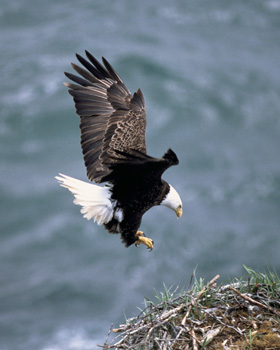 | asheville business & community directory |
|
This is an archived page that may contain outdated or incorrect information. Please visit www.Asheville.com for the latest news, events, and more.
 Eagles are a member of the Accipitridae family that also includes hawks, kites, and vultures. The Bald eagle is one of the largest birds of prey, with the female bald eagle measuring 35 to 37 inches and a wingspan that measures from 79 to 90 inches. Male bald eagles measure from 30 to 34 inches and a wingspan from 72 to 85 inches. Bald eagles typically weigh from 10-15 pounds, with the northern birds significantly larger than their southern cousins.
Eagles are a member of the Accipitridae family that also includes hawks, kites, and vultures. The Bald eagle is one of the largest birds of prey, with the female bald eagle measuring 35 to 37 inches and a wingspan that measures from 79 to 90 inches. Male bald eagles measure from 30 to 34 inches and a wingspan from 72 to 85 inches. Bald eagles typically weigh from 10-15 pounds, with the northern birds significantly larger than their southern cousins.
There are two subspecies of bald eagles. The �southern� bald eagle, Haliaeetu leucocephalus leucocephalus, found from Texas and California to South Carolina and Florida. The �northern� bald eagle, Haliaeetus leucocephalus alascanus, found primarily in the Pacific Northwest and Alaska. In truth, there is no single cause for the rapid decline in the bald eagle population. Like with many species, as the human population grew and expanded across the continent, the eagle population declined. Food supplies decreased as people hunted and fished over the eagle habitat. Eagles, like their human counterparts, are at the top of the food chain, essentially competing with us for the same food, though we obviously have the advantage of weapons. During the Second Continental Congress in 1782, our forefathers would adopt the Bald Eagle as the official emblem of our new nation. At that very moment, there were as many as 100,000 Bald Eagles nesting in the still expansive and virtually uninhabited territory that is now the lower 48 states. As more and more people migrated westward, the natural habitat of the eagles grew smaller and smaller, leaving them few places to nest and hunt freely without human interference. For these reasons, the population of bald eagles began to rapidly decline by the late 1800s. By the 1930s, as the American people became aware of the diminishing bald eagle population, efforts were made to protect the remaining wild eagle populations. In 1940 the Bald Eagle Act was passed, effectively reducing harassment by humans. Although the eagle began a slow recovery, the use of DDT and other pesticides were now being used throughout the eagle habitat. These pesticides were sprayed on plants that were eaten by small animals like mice, and those smaller animals were later consumed by birds of prey. The DDT harmed both the adult birds and the eggs that they laid, with the shells becoming too thin to survive the incubation period, often being crushed. Typically, eggs that were not crushed often did not hatch. As many bald eagles were found dead or dying all over the country, scientist would discover lethal quantities of DDT and other pesticides in the fatty tissues and gonads, making many of them infertile. Another threat was misinformed people. From 1917 through 1953, over 100,000 bald eagles were killed in Alaska alone, as fisherman dependent on salmon for their livelihood, believed them a threat to the salmon population. In 1967, Bald eagles were officially declared an endangered species in all areas of the United States under a law that preceded the Endangered Species Act of 1973. The Endangered Species Act was signed into law in 1973 by President Richard Nixon. This landmark legislation is still regarded as one of the most important wildlife conservation laws in the world. Government agencies and many private organizations, successfully sought to alert the public about the eagle�s fight for life and to protect their habitat. Three years later, on July 4, 1976, the US Fish and Wildlife Service officially listed the bald eagle as a national endangered species. In 1963 the United States bald eagle population had been reduced to just 417 known breeding pairs, it is estimated that there are more than 7,678 pairs of bald eagles today. Even with decades of protection, there is still only an estimated 70,000 bald eagles in the world, with half living primarily in Alaska, flourishing in part because the salmon and because of greater undisturbed habitat. On Saturday, May 15, 2004, the Bush administration announced the removal of the American Bald Eagle from the threatened species. The birds will still be safeguarded under the federal Bald Eagle Protection Act of 1940. There are still many dangers to the survival of the Bald Eagle, including illegal hunting by people wanting their feathers and feet to sell on the black market; power lines; lead poisoning; vehicles; and even starvation due to continued loss of habitat. It is clear that if the bald eagle is to survive, and thrive, in the wild, we must continue to protect their habitat and support rehabilitation and reintroduction efforts. In the Carolinas there are currently six National Wildlife Refuges (NWR)with bald eagles. In North Carolina: Alligator River NWR; Mattamuskeet NWR; and Pea Island NWR. In South Carolina: Cape Romain NWR; Carolina Sandhills NWR: and Santee NWR. (Image provided by the US Fish and Wildlife Service. Story by Deborah Ray, Executive Director Native Communications.)
|
